04.04.2005
S. Ivanov. Theoretical survey of the Linares tournament
Commentators and professionals have generally agreed that this year supertournament in Spain turned out to be more vivid and interesting than previous. Anyway the unpalatable label 'drowsy Linares' wasn't applied to the last competition. It doesn't matter what caused this pleasant phenomenon: denial of organizers to pay extra fees and creation of quite large prizes instead of them (I remind you that the first prize was 100 000 Euro, the second one - 75 000 and so on), fighting spirit of most players or the fact that for Garry Kasparov it was the last professional tournament in a career and he really wanted to 'slam the door', so he went all out and inspired other players with his energy. What is more important is that this year's tournament saw many brilliant and unforgettable encounters, splendid examples of both attack and defense were demonstrated, and the opening theory made a considerable headway. Mostly players started the game with the king's pawn – 27 times, with a result +4 –2 =21 in favour of White. It's striking but the bloodiest fight occurred in closed openings when White started with 1.d4 – 9 games out of 12 ended decisively, with minimal advantage on the White's side: +5 –4 =3. In 3 games White made the first move 1. ¤f3 and proceeded to the English Opening build-up – all games ended up as draws. Sicilian Defense The Naidorf Variation In the English attack we witnessed two principled encounters. P.Leko (2749) – G.Kasparov (2804) B90 (1st round) 1.e4 c5 2.¤f3 d6 3.d4 cxd4 4.¤xd4 ¤f6 5.¤c3 a6 6.f3 e6 7.Ґe3 b5 8.Јd2. Theory assumes that it's more accurate to play first 8.g4 and then 8...h6 (8...¤bd7 is now wrong because of 9.g5) 9.Јd2. 8...¤bd7 9.g4 ¤b6!? Now Black isn't obliged to play 9...h6. The text vacates the square d7 for the king's knight and prepares for an offensive game at queen's flank. 10.a4. White at once clears up confusion on a queenside. 10.g5 ¤fd7 leads to a very complicated game, for example: 11.Ґd3 Ґb7 12.0–0–0 ¦c8 13.ўb1 ¤e5 14.Јe1 Ґe7 15.h4 b4 16.¤ce2 d5› Mamedov – Efimenko, Oropesa 2001. 10...¤c4. Meanwhile Kasparov keeps to the offbeat track. In case of 10...b4 11.¤a2 a5 12.c3 bxc3 13.¤xc3 odds of White are better. Also 10...bxa4 11.¤xa4 ¤xa4 12.¦xa4 Ґb7 13.¤b3 d5 14.¤a5 Ґc8 15.g5 ¤d7 16.¤c6 Јc7 17.exd5 ¤b6 18.¦e4!± happened before – Black didn't manage to cope with opening problems (Edelman – Yudasin, USA 1990). 11.Ґxc4 bxc4 12.a5. In a blitzgame Anand – Kasparov (Iceland 2000) was played 12.0–0 Ґb7 13.g5 ¤d7 14.f4 ¤c5 15.Јg2 g6 16.¦ad1 Јc7 17.Јg4 h6 18.f5 gxf5 19.exf5 e5 20.¤e6?! fxe6 21.Јh5+ ўd8 22.f6 Јc6 23.¦d2 ўc7 – Black repulsed White's pressure and won soon. The move made by Leko seems to be more in the manner of the variation: not determining king's position White gains space on queen's flank to have a free hand there. 12...Ґb7 13.¤a4 ¦c8!? A novelty. The jump of White knight on b6 wasn't so dangerous to Black. After sharp 13...d5 14.e5 ¤d7 15.f4 Јh4+ 16.Ґf2 Јxg4 17.¦g1 the players in the game Vescovi – Gelfand (Bermudas 2005) preferred to get out of harm's way and agreed the draw. But in case of passive 13...¤d7 14.0–0–0 Јc7 15.¤e2 Ґe7 16.¤b6 ¤xb6 17.Ґxb6 Јc6 18.¤c3 0–0 19.¦he1 ¦fe8 20.f4 White obtains an evident advantage (Anand – Kulaots, Tallinn 2004). 14.Јc3. Definitely the strong answer. In case of 14.¤b6 Leko probably wouldn't like the pawn's sacrifice: 14...c3!? (although there is a simple 14...¦c7) 15.bxc3 ¦c7, for example: 16.0–0 Ґe7 17.¦ab1 0–0 followed by ¤d7-e5 or with an exchange on b6 – Black has counterchances. 14...¤d7. Alas, after a long consideration Kasparov didn't make up his mind to the piece sacrifice.: 14...Ґxe4!? Current position seemed to be quite new even for him, and it was impossible to count all variations sitting at the board. Although such turn of the game was entirely in style of 13th world champion. Let's try to understand what is going on: 15.fxe4 (15.¤b6 ¤d5!) 15...¤xe4 16.Јb4 (the only move) 16...Јh4+ 17.ўd1 Јxg4+ 18.ўc1 (White king should escape to queen's flank; 18.ўe1? Ґe7 … Ґh4°) 18...e5 (worse is 18...d5 19.Јb7 e5 20.¤b6! exd4 21.Ґxd4ќ). Now White has 2 acceptable responses: 19.Јb7 exd4 20.Ґxd4 Ґe7 21.¦e1!? d5 (21...Јf4+ 22.Ґe3 Јf5›) 22.Ґxg7 ¦g8 23.¤b6 ¦d8 24.Јc6+ ¦d7 25.Јc8+ Ґd8 with a very complicated play; 19.¤b6!? exd4 20.¤xc8 dxe3 (probably, 20...Јxc8!? 21.Јa4+ ўe7 22.Ґxd4 f6 … ўf7› is stronger) 21.Јb8! (21.Јxc4 e2µ). Both sides have queen and knight in attack, but White king nevertheless is better protected. 21...Ґe7 (или 21...e2 22.¤b6+ ўe7 23.¤d5+ ўd7 24.Јc7+ ўe8 25.Јc6+ ўd8 26.¦a4!ќ) 22.¤xd6+ (but it isn't worthy of being greedy – 22.¤xe7+ ўxe7 23.Јxh8? Јg2 24.¦d1 e2 25.¦e1 Јf1°) 22...ўd7 23.Јb7+ ўxd6 24.¦d1+ ўe5 (24...¤d2 25.Јb6+ ўe5 26.Јxe3+ ¤e4 27.Јd4+ ўf5 28.Јd7+ќ) 25.Јxe7+ Јe6 26.Јc7+ (the endgame is by no means clear: 26.Јxe6+ ўxe6 27.¦e1 f5 28.¦xe3 g5„) 26...ўf5 27.¦f1+ ¤f2 28.¦a3 ¦e8 29.Јc5+ Јe5 30.Јxc4 ¦e6 31.¦e1±, and White, having gradually consolidated their forces, obtains an advantage. Obviously in one or another case reinforcement is possible, but anyway the move 14...Ґxe4!? is more interesting than the course of the game that was chosen by Kasparov. 15.0–0–0 Ґe7 16.h4! As a result, Kasparov found himself in a rather unpleasant situation. White king is better protected than his vis-à-vis. 16...Ґxh4. Casting prudence to the winds. In case of 16...0–0 17.g5 Black risks to get mated soon. 17.¤e2?! Strange move. For some reason Leko stops on the half-way. With a simple 17.Јb4 ¦b8 (totally bad is 17...¦c7 18.¦xh4! Јxh4 19.Јxd6 Јd8 20.¤b6 ¤xb6 21.Јxd8+ ўxd8 22.¤xe6+ ўe7 23.¤xc7ќ) 18.Јxd6 Ґe7 19.¤c6 Ґxd6 20.¤xd8 ¦xd8 21.¦xd6 White would have stable advantage in the endgame. 17...Ґf6 18.Ґd4 e5. Now the d5 square is weakened, but naturally Kasparov hardly wanted to play with the 'bishop-pawn' on b7 after 18...d5 19.e5 Ґe7 20.f4 and so on. 19.Ґe3 Ґe7 20.ўb1 Јc7. Black has problems with his king, but he still posesses an extra pawn. 21.¤b6 ¤xb6 22.axb6 Јd7 23.¦h5 f6. Sound decision! The king can hide on f7 if something happens. 24.¤g3 g6 25.¦h2 0–0. Black finally castles. The rook on f7 will safely protect the pawn h7. 26.¦hd2. White let the whole advantage slip out of his hands. Here Kasparov could start playing for a win, but he had little time left, therefore draw seems to be quite appropriate result. Ѕ–Ѕ V. Anand (2786) – V. Topalov (2757) B90 (2nd round) 1.e4 c5 2.¤f3 d6 3.d4 cxd4 4.¤xd4 ¤f6 5.¤c3 a6 6.Ґe3 e6 7.f3 b5 8.g4. A critical move that doesn't offer Black an alternative. 8...h6 9.Јd2 b4. Nowadays it's the most fashionable continuation. The alternative is 9...¤bd7 10.0–0–0 Ґb7 11.h4 b4 ит.д. 10.¤a4 ¤bd7 11.0–0–0 ¤e5!? Topalovboldly decides to follow the variation, which brought him the stunning victory over Kramnik at the beginning of this year in Wijk aan Zee. It's clear that he couldn't but understand that the rivals would invent something... 12.b3. A novelty from Anand! Just in case he clears an escape route for the knight on a4. Kramnik played 12.Јxb4 Ґd7 13.¤b3 ¦b8 14.Јa3? (it would be better to play 14.¤b6 or 14.Ґb6) 14...¤xf3 15.h3 ¤xe4 16.Ґe2 ¤e5 17.¦he1 Јc7 18.Ґd4 ¤c6 19.Ґc3 d5 20.¤bc5 Јa7, and White resigned (Kramnik – Topalov, Wijk aan Zee 2005). A new idea for White was demonstrated in the recent game Bacrot – Dominguez: 12.¤b3 ¦b8 (12...¤xf3!?) 13.Ґa7 ¦b7 14.Јf2 Ґd7 15.Ґd4 Јc7 (15...¤exg4!? 16.fxg4 ¤xg4›) 16.Ґxe5 dxe5 17.¤ac5 Јb6 18.Јg1! ¦a7 19.¤d3 Јxg1 20.¦xg1 Ґd6 21.f4! Ґc7 22.fxe5 ¤xe4 23.Ґg2 ¤g5 24.¦ge1ќ, Poikovsky 2005. 12...d5!? The most radical reply. Also possible is 12...Ґd7 13.Јxb4 ¦b8 14.Јc3 etc. 13.Ґf4 Ґd6. Black only needs to castle and his position will be OK, but it's White's turn to play... 14.Ґxe5 Ґxe5 15.¤c6. The dangerous bishop should be wiped out. In case oftimid15.Јxb4 ¦b8 16.Јc5 ¤d7! White has serious problems. 15...Јc7 16.¤xe5 Јxe5 17.Јxb4 dxe4 Black king isn't protected so far, but Black managed to sweep away White's pawn centre. Which of these factors will turn out to be more important? As compared with the move in text, worse is 17...¦b8 18.Јc5!, and it isn't clear what to do next. 18.¤b6 ¦b8 19.ўb1! (to prevent a troublesome check at a1) 19...Јc7 20.Јa4+ ўf8! Much weaker is 20...¤d7?! 21.¤xd7 Ґxd7 22.Јd4 e5 23.Јxe4 Ґc6 24.Јf5 – black has no compensation for the pawn. 21.¤xc8 ¦xc8. Owing to the attack at the pawn c2, Black has time to defuse the situation. 22.Јc4. After22.Ґxa6 Јxc2+ 23.ўa1 Јc3+ Black produces a perpetual check. 22...Јxc4. In case of 22...¤d5 23.Јxc7 ¦xc7 24.Ґxa6! ¤c3+ 25.ўb2 ¤xd1+ 26.¦xd1 ўe7 27.fxe4± White obtains an advantage because of three passed pawns. However, 22...exf3!? 23.Јxc7 ¦xc7 24.¦d8+ ¤e8 25.Ґxa6 ўe7 26.¦b8 g5 27.Ґb7 h5 leads to the ending that was very difficult to estimate. Topalov chooses the most natural way. 23.Ґxc4 a5. Keep the a-pawn is useful, of course. 24.Ґa6 ¦b8 25.fxe4 Now the simplest is to play 25...ўe7, connecting the rooks at the next move, Black regains the pawn, whereupon an almost equal but double-edged position arises. Veselin chose the most sharp and complicated way, and his eventual defeat has nothing to do with the opening: Topalov's idea 11...¤e5!? withstood the new test at the highest level. In the next game where the 6...e5 was played, beautiful and original moves followed one another. V.Topalov (2757) – F. Vallejo (2686) B90 (6th round) 1.e4 c5 2.¤f3 d6 3.d4 cxd4 4.¤xd4 ¤f6 5.¤c3 a6 6.Ґe3 e5 7.¤b3 Ґe7. The course7...Ґe6 8.f3 ¤bd7 now is more popular. 8.f3 Ґe6 9.Јd2 0–0 10.0–0–0 ¤bd7 11.g4 b5. Classic Sicilian position with opposite castles. 12.g5 b4. Last years fashion.Earlier one usually played 12...¤h5, which permits the invasion of white knight on d5. 13.¤e2 ¤e8. Now in case of13...¤h5 14.¤g3 ¤f4 15.h4 a5 16.ўb1 a4 17.¤d4!? exd4 18.Ґxf4 White's odds are higher (Topalov – De Firmian, Poland 1995). 14.f4!? White advances o the storm without any doubts. More cautious 14.ўb1 also occurred. 14...a5 15.f5 a4 The tension of the struggle has reached its peak. 16.fxe6. In the correspondence game a purely computer moveoccurred: 16.¤bd4, and after 16...exd4 17.¤xd4 b3 18.ўb1 bxc2+ (18...bxa2+!? 19.ўa1 ¤c5 20.fxe6 ¤xe6›) 19.¤xc2 Ґxa2+ 20.ўxa2 ¤e5 21.¤d4 Јb8 22.h4 d5 23.exd5 Јb7 the sides have reached an extremely sharp position (van Kempen – Timann, 2004). 16...axb3 17.exf7+. Anovelty. The move looks more than natural, but the exposed f-file only suited Black so far. The essence of the White's idea is shown only on the next move. Earlier White proceeded with 17.cxb3 fxe6 18.ўb1 Јa5 (18...¦xa2!? 19.ўxa2 Јa8+ 20.ўb1 Јxe4+ 21.Јd3 Јxh1 22.Ґh3 Јc6 23.Ґxe6+ ўh8›) 19.¤c1 ¤c7 20.Ґh3 g6 21.¦hf1 ¦xf1 22.¦xf1 ¤c5 23.Јf2 ¦f8 24.Јc2 ¦xf1 25.Ґxf1 d5, and White has nothing (Ivanovich – Djukanovich, Bielo-Pole 2004). 17...¦xf7 18.ўb1!! Brilliant idea! Only a player with remarkable imagination could find such a move. Trivial ways aren't so good: 18.cxb3 ¦xa2 19.ўb1 Јa5 (probably 19...Јa8 20.¤g3 ¦xf1!? 21.¦hxf1 ¦a1+ 22.ўc2 Јc8+ 23.ўd3 Јa6+ with a perpetual check) 20.¤c1 (20.¤g3? Ґxg5! 21.Ґxg5 ¤b6 … ¦c7°) 20...¦a1+ 21.ўc2 ўh8›. 18...bxc2+. In case of 18...bxa2+ 19.ўa1 White king hides behind Black pawn a2 as behind a stone wall, and White can quietly begin his attack. 18...¦xa2 isn't good as well: 19.¤c1 Јa8 (19...bxc2+ 20.Јxc2±) 20.¤xb3, and White has a definite advantage. 19.ўxc2. It would be great to take with the queen, but then the important pawn on g5 is lost: 19.Јxc2 Ґxg5. 19...¤b6. In subsequent games Black played 19...¤c5?! and quickly collapsed: 20.¤g3 ўh8 21.Ґc4 Јc8 22.ўb1 ¦f8 23.¦hf1 ¤c7 24.Ґxc5 ¦xf1 25.¦xf1 dxc5 26.¦f7 Ґf8 27.¦xc7 Јxc7 28.Јd5 1–0 (Ivanovic – Benderats, Bar 2005). The move made by Vallejo is stronger – it's necessary to seize control over the important c4 square. 20.¤c1 d5! Another strong response: Black blocks up the dangerous diagonal and brings his inactive knight on e8 back into play. 21.exd5 ¤d6 22.ўb1. 22.g6!? was worthy of consideration: 22...hxg6 23.ўb1. Since White loses the g-pawn anyway, than at least he can spoil the opponent's pawn structure. But Topalov seemed to forebode something... 22...¦f3? Alas,Vallejo spoils this perfectly played game with a single poor move. Obvious 22...¤bc4 23.Ґxc4 ¤xc4 24.Јe2 ¤xe3 25.g6!? (25.Јxe3 Ґxg5і) 25...hxg6 26.Јxe3 leads to a position of dynamic equilibrium. 23.h4! This resource was blundered by Black. The threat of knight's invasion on c4 turns out to be only a bogus. 23...¤a4. After 23...¤bc4 24.Ґxc4 ¤xc4 25.Јe2! ¦xe3 26.Јxc4 Ґd6 27.¦he1± advantage of White is incontestable. 24.Јe2 ¦g3 25.Ґf2 ¦c3 26.Јxe5!ќ. Simple and strong. Black didn't manage to create any threats, and White begins decisive attack. 26...¤xb2 27.Ґd4 Ґf8 28.ўxb2 ¦f3 29.Ґd3 ўh8 30.Јe2 ¦f4 31.Јh5 ¤f5 32.g6 1–0 The Scheveningen Variation A quite rare variation occurred in the following encounter, which is noteworthy because it succeeded in improving the game of Kasparov himself. P. Leko (2749) – V. Topalov (2757) B84 (11th round) 1.e4 c5 2.¤f3 d6 3.d4 cxd4 4.¤xd4 ¤f6 5.¤c3 a6 6.Ґe3 e6 7.Ґe2. Instead of the English Attack White leads the game to the Scheveningen Variation. 7...Ґe7. In the 8th round encounter with Adams Topalov chose the rare 7...¤bd7, and after 8.g4 h6 9.f4 g6 10.h3!? b5 11.Ґf3 Ґb7 12.e5! faced serious difficulties. Now he prefers standard development. 8.f4 0–0 9.g4!? This aggressive lunge is uncommon, but it demands certain accuracy from Black. After 9.0–0 ¤c6 an ordinary Scheveningen develops. 9...d5. Competent reaction, everything like the classics taught us: meet a flank attack with a central activity. An alternative is 9...b5 10.g5 ¤fd7 11.a3 Ґb7 12.¦g1 ¤c5 13.f5, but White seriously livens up on a kingside (Short – Kasparov, Reykjavik 2004, rapid chess). 10.e5 ¤e4 11.¤xe4. The move11.Ґd3 is more suitable for friendly games in a park: 11...Ґh4+ 12.ўf1 ¤xc3 13.bxc3 f6! 14.exf6 Ґxf6 15.ўg2 e5 16.fxe5 Ґxe5 – White king is exposed too much. 11...dxe4 12.g5. White gains the space on a kingside. Now he has to secure the king and he can proceed to the vigorous activity. 12...Јb6. A timelyreaction. 12...Јc7 13.Јd2 ¦d8 14.0–0–0 b5 15.ўb1 Ґb7 16.Јc1 Ґd5 17.h4 ¤c6 18.¤xc6 Јxc6 19.h5 occurred in Lanka – Gavrikov, Austria 2004 (Ѕ–Ѕ). 13.¤f5. The pawn b2 needs to be defended, and 13.¦b1 isn't desirable – what would White do with his king? 13...Јa5+ [wrong is 13...Ґc5? 14.Ґxc5 Јxc5 15.Јd6ќ] 14.Ґd2 Ґb4!? Great novelty. Judging by the time used, Topalov invented it at the board. In 2 games where this position occurred earlier Black retreated with the queen: 14...Јc5 (or 14...Јc7) 15.¤xe7+ Јxe7 16.c3 b5 17.Ґe3 ¦d8 18.Јc2 Ґb7 19.ўf2 (or 19.¦d1 Ґd5 20.0–0 ¤d7 21.b3 ¤c5 22.¦d4 g6 23.¦fd1 ¦dc8 24.Јd2 ¤d3 25.Ґxd3 exd3 26.¦xd3 a5 with the counterplay for Black, Shaposhnikov – Naier, St-Petersburg 2003) 19...¤d7 20.b4 ¤f8 21.h4 Јc7 22.h5 ¤d7 23.h6 g6 24.a4 ¤b6 25.axb5 axb5 26.ўg3 ¤c4 with approximate equality (Shirov – Kasparov, Linares 2001). 15.¤e3. The reply of White is almost forced. In case of 15.¤d6?! e3 16.Ґc3 (16.Ґxb4 Јxb4+ 17.c3 Јxf4°) 16...Ґxc3+ 17.bxc3 Јxc3+ 18.ўf1 Ґd7! only Black has chances. Also after 15.c3?! exf5 16.cxb4 Јb6µ centralized white king gets under attack. 15...¦d8 16.c3 Ґe7 17.Јc2 b5 A key moment of the game. Can White capture on e4? 18.a4. Leko decides against it and probably he is right. After 18.Јxe4 the game could proceed in the following way: 18...¦a7! [18...Јb6 19.Ґf3 ¦a7 (19...Ґd7 20.Јb7!) 20.¤c2 Ґb7 21.Јe2 Ґxf3 22.Јxf3 ¦ad7 23.Ґe3 Ґc5 24.Ґxc5 Јxc5 25.¤d4 ¦d5© … 26.0–0 ¤c6 – probably Black regains the pawn with equality] 19.Јc2 (19.Ґd3? g6 20.¤g4 ¦ad7!°) 19...¦ad7 20.¦d1 (indeed he shouldn't play 20.Ґc1?) 20...Ґb7 21.0–0 Ґc5 (21...Јxa2›) 22.Ґc1 Јb6 23.ўf2 Јc6 24.¦g1 ¦xd1 25.Ґxd1 ¤d7 – Black's compensation is more than adequate. 18...Ґb7 19.b4. And suddenly the players agreed a draw in this complicated and unclear position.Ѕ–Ѕ The Sveshnikov Variation There were some bolds that decided to play this variation as White. And as it turned out, 'he is not so black as he is painted', – in both games Black had problems surviving the openings. V. Topalov (2757) – P. Leko (2749) B33 (4th round) 1.e4 c5 2.¤f3 ¤c6 3.d4 cxd4 4.¤xd4 ¤f6 5.¤c3 e5 6.¤db5 d6 7.Ґg5 a6 8.¤a3 b5 9.¤d5 Ґe7 10.Ґxf6. Anand achieved nothing in the game with Leko in the Round Ten playing the rare 10.¤xe7 ¤xe7 11.Јd3 d5! (this is simpler than previously played 11...Ґb7) 12.exd5 Ґf5 13.Јb3 Јxd5 14.Јxd5 ¤exd5 15.c4 bxc4 16.Ґxc4 (the only way to search for the advantage is 16.¤xc4) 16...0–0 17.0–0 ¤b4 18.¦fe1 ¦fe8 19.¦ad1 ¤e4 20.Ґe3 ¦ac8 21.f3 ¤f6 22.¦e2 Ґe6 23.b3 e4 24.¦dd2 Ѕ–Ѕ. 10...Ґxf6 11.c3 0–0 12.¤c2 Ґg5 13.a4 bxa4 14.¦xa4 a5 15.Ґc4 ¦b8 16.b3 [an alternative is 16.¦a2, but we'll talk about it later] 16...ўh8 17.¤ce3. White shouldn't allow the f7-f5 break. Black has no problems in case of 17.Јe2 f5 18.h4 Ґf6 19.exf5 Ґxf5 20.¤ce3 Ґd7 21.Ґd3 ¤e7 22.¤xe7 Јxe7 23.¤d5 Јf7 24.¦xa5 Ґd8 25.¦a7 Јxd5 26.¦xd7 ¦xb3= Polgar – Kramnik, Wijk aan Zee 2005, or 17.0–0 f5 18.exf5 Ґxf5 19.¤ce3 Ґg6 20.¦e1 ¦b7 21.Ґd3 Ґxd3 22.Јxd3 Ґxe3 23.fxe3 ¦xb3 24.Јc4 ¦b2 25.Јxc6 Јg5 26.¤f4 exf4 27.¦xf4 ¦fb8 Ѕ–Ѕ Anand –Kramnik, Wijk aan Zee 2005. 17...g6 18.h4! Sacrificing the pawn, White begins the play against Black's king. 18...Ґxh4 19.g3 Ґg5 20.f4!? Very interesting novelty. White explodes the centre at once, keeping Black from reducing the pressure with exchanges. 20.¦a2 Ґxe3 21.¤xe3 Ґe6 (или 21...f5 22.¦d2 f4 23.gxf4 exf4 24.¦xd6 Јc7 Amonatov – Van Wely, Moscow 2005) 22.¦d2 Јe7 23.¦xd6 ¤d4 24.¦d5 ¤c6 Ѕ–Ѕ occurred in Baramidze – Jakovenko, Izmir 2004. 20...exf4 21.gxf4 Ґh4+. Temporarily breaking the coordination of White pieces. In case of natural 21...Ґf6?! 22.¦a2 Ґg7 23.¦ah2 h6 24.Јc2! with following ¦h6 White has a very strong attack. 22.ўd2 ¤e7 (Black has to exchange at least a pair of minor pieces) 23.ўc1 ¤xd5 24.¤xd5 Ґe6. Andhere after 24...Ґf6 25.¦a2 Ґg7 26.¦ah2 h6 27.f5 Black is in trouble. 25.Јd4+ ўg8 26.¦a2. With a dangerous threat ¦ah2; 26.f5 Ґxd5 27.Ґxd5ѓ is also interesting. 26...Ґxd5 27.Јxd5. Now a bold attack does not work: 27.Ґxd5 Ґf6 28.e5 Ґg7 29.¦ah2? dxe5 30.fxe5 Јg5+ 31.ўc2 Ґxe5°. 27...Јf6 28.Јd2. Temporary retreat. 28...Ґg3. After the game Leko criticized this move, but does Black have something better? 29.¦f1 h5 30.¦xa5 So White had regained a pawn keeping the initiative. Only a miracle allowed Leko to save this game. V. Anand (2786) – G. Kasparov (2804) B33 (6th round) 1.e4 c5 2.¤f3 ¤c6 3.d4 cxd4 4.¤xd4 ¤f6 5.¤c3 e5 6.¤db5 d6 7.Ґg5 a6 8.¤a3 b5 9.¤d5 Ґe7 10.Ґxf6 Ґxf6 11.c3 0–0 12.¤c2 Ґg5 13.a4 bxa4 14.¦xa4 a5 15.Ґc4 ¦b8 16.¦a2 ўh8 17.¤ce3 g6 18.0–0 Sensational game Ponomariov – Kramnik went on as follows: 18.h4!? Ґxh4 (18...Ґh6 19.h5 ўg7) 19.g3 Ґf6 20.b3 (the idea of Topalov in a slightly different version was tested in the Russian junior championship that had just finished: 20.f4 exf4 21.gxf4 Ґh4+ 22.ўd2 ¦g8 23.ўc1 ¦g7 24.b3 ¤e7 25.Јd4 ¤c6 26.Јd3 ¤e7 27.ўc2 ¤xd5 28.Ґxd5 Ґf2 29.Јd2 Ґxe3 30.Јxe3 f6 31.¦ha1, and White's has better chances, Khairullin – V. Kuznetsov, Nojabrsk 2005) 20...Ґg7 21.f4 exf4 22.gxf4 ¦e8 23.Јf3 ўg8 24.¦ah2 h5 25.¦xh5!? gxh5 26.Јxh5 with the strong attack (Ponomariov – Kramnik, Wijk aan Zee 2005). Anand prefers quieter play. 18...f5 19.Јa4!? Preliminary exchange on f5 promises White nothing: 19.exf5 gxf5 20.Јh5 [20.Јa4 Ґd7 21.Ґb5 Јc8 (it's also possible to play 21...f4 22.Ґxc6 Ґxc6 23.Јxc6 fxe3 24.¤xe3 Ґxe3 25.fxe3 ¦xf1+ 26.ўxf1 Јe7 27.b4 axb4 28.cxb4 Јe6 Ѕ–Ѕ R.Zimmerman –Bush, Germany 1995) 22.f4 ¦xb5 (22...exf4!?) 23.Јxb5 exf4 24.¤b6 Јb7 25.¤ed5 Ґd8 26.ўh1 ¤e5 27.Јxa5 Ґe6 with a complicated game, Cholovitch – Nedev, Star-Dojran 1996] 20...e4 21.f4 exf3 22.gxf3 Ґxe3+ 23.¤xe3 ¤e5 24.Ґd5 Ґa6 25.¦d1 Ґb7! 26.ўh1 Јb6і (Christianson –Tregubov, Selfoss 2002). In the following game White played entirely insipid: 19.Јd3 f4 20.¤c2 f3! 21.g3 h5 22.b4 h4 23.b5 ¤e7 24.¤ce3 ¤xd5 25.¤xd5 Ґb7 26.ўh1 Јc8, and Black developed a strong contreplay (Snapik – Li, Thessaloniki 1984). 19...Ґd7 20.Ґb5 Crucial moment of the opening stage. 20...¦xb5. The move which is called for doesn't bring Black the equality. It was difficult for Kasparov to decide on 20...¤b4!? without preliminary analysis, although the variations show that one can play like this: 21.Ґxd7 ¤xa2 22.Ґb5 (22.b3 ¤xc3! 23.¤xc3 ¦b4 24.Јc6 ¦f7µ; 22.exf5 ¦xb2 23.¤c4 ¤xc3! 24.¤xc3 ¦b4 25.Јc6 ¦xc4 26.Јxc4 Јxd7 27.fxg6 hxg6і) 22...f4 23.¤c4 f3 24.g3 ¤c1! (what a knight!) 25.¤xa5 ¤e2+ 26.ўh1 ¦f7!і. The move 20...Јc8!? demands an attentive consideration. For example, 21.¤c4 (21.exf5 Јb7! 22.c4 gxf5 23.f4›) 21...¦xb5 22.¤xd6! Јb8 23.¤xb5 ¤a7 24.c4 ¤xb5 25.¦fa1 ¤c3! 26.Јxd7 ¤xa2 27.¦xa2 Јb3 with relatively equal chances. 21.Јxb5 ¤b4 22.Јxa5 ¤xa2 23.Јxa2 fxe4. Only here Black deviated from the original game. In the encounter Novik – Filippov (St. Petersburg, 1994) Black played 23...f4, and after 24.¤c2 f3 25.g3 Ґc6 26.¦d1 Јd7 27.¤e1 h5 28.Јa3! Ґh6 29.c4! White gradually converted his advantage. Kasparov seems to make everything right: having 2 bishops, he opens the position, but he's not able to change the evaluation. 24.b4! Now it becomes evident that White has a steady edge. He keeps the knights on the central squares and simply pushes the passed b-pawn. It's interesting that this move was cited in comments to the aforementioned game in the 62nd volume of the Informant. 24...Ґe6 25.c4 Јc8 26.Јb3 ўg7 27.¦b1 ¦f7±. Only the tenacious defense by Kasparov and the inaccuracies that were made by Anand allowed Black to save half a point. Petroff Defense In this opening Black seemed to be okay, rather White should worry about the equality. P. Leko (2749) – M. Adams (2741) C42 (9th round) 1.e4 e5 2.¤f3 ¤f6 3.¤xe5 d6 4.¤f3 ¤xe4 5.d4 d5 6.Ґd3 ¤c6 7.0–0 Ґe7 8.¦e1 Ґg4 9.c3 f5. One of the sharpest variation that could appear in this quite calm opening. 10.Јb3 0–0 11.¤bd2. As practice has already shown after 11.Јxb7 ¦f6 the initiative of Black is strong enough. 11...¤a5 12.Јc2 [an alternative to the text – 12.Јa4 ¤c6 13.Ґb5] 12...¤c6. In the encounter with Leko in the 3rd round in the variation 12...Ґd6 13.¤e5 Anand made a quite natural move 13...Ґh5!?, that turned out to be not a bad novelty (occurred 13...Ґxe5 14.dxe5 Јh4 15.¦f1 ¤c6 16.f4 Јe7 17.¤f3 Јc5+ 18.ўh1 ¦ad8„ P. Smirnov – Ivanchuk, Yerevan 2004). After 14.b4 ¤c6 15.¤df3 ¦e8 16.Ґb2 Јf6 17.Јb3 ўh8! Chances of Black turned out to be even more preferable. 13.b4 a6 14.a4 Ґd6 15.¦b1. A new idea. In the following encounter the White opening was worse: 15.Ґa3 ўh8 16.b5 axb5 17.Ґxd6?! (лучше 17.axb5!?) 17...cxd6! 18.axb5 ¤a5! 19.h3 Ґh5 20.¤h2 ¦c8 21.¦a3 b6 22.¤df1 f4!і Ponomariov – Adams, Wijk aan Zee 2005. 15...¦e8 16.b5 axb5 17.axb5 ¤a5 18.¤e5 White seems to get his own way: the Black knight is pushed on the side of the chess-board, e5 square is captured, he has only to play f2-f3. But... 18...Ґxe5 19.dxe5 ¤xf2!? This standard blow abruptly changes the course of action, White won't have a peaceful life. However one could manage without sacrifices: 19...Јh4. For example: 20.¤f1 c5 21.bxc6 ¤xc6 22.Ґf4 Ґd1! 23.¦exd1 Јxf4, and the situation of Black is none the worse. 20.ўxf2?! Extremely risky reply. One could fight for an advantage by means of 20.Ґxf5, e.g.: 20...Ґxf5 ( 20...ўh8!? is evidently stronger) 21.Јxf5 ¦f8 22.Јe6+ ўh8 23.Ґa3 ¦e8 24.Јf5 ¤c4 25.¤xc4 dxc4 26.Јxf2 ¦xa3 27.¦bd1 Јe7 28.e6±. 20...Јh4+ 21.ўf1 Јxh2. Black has no concrete threats so far, the opened position of the White king gives at least sufficient counterchances. 22.Ґa3 ¦e6!, moving pieces closer up for an attack. 23.Јa2 ¦d8 24.Ґc5 Crucial moment of the game. 24...¦h6. It makes the aim of White easier. Considerably stronger was 24...¦g6!, intending to capture a king over open sights. White has to play almost the only possible move 25.¦b2! (25.Јxa5? Ґf3!° is bad; or 25.Ґg1 Јf4+ 26.Ґf2 ¦h6 27.ўg1 Јh2+ 28.ўf1 Јh1+ 29.Ґg1 ¦h2 30.¤b3 ¦xg2 31.Јxg2 Ґh3°) 25...b6 26.Ґe3, and now Black can choose – to give the perpertual check (26...Јh1 27.ўf2 Јh4) or to play wins by 26...Јg3. 25.e6. And now already Leko can play for the win after 25.Ґe2!?, since by this time he cannot avoid the perpetual check: 25...Јf4+ 26.ўg1 (26.¤f3 ¤c4!) 26...Јh2+ 27.ўf2! Јh4+ (27...Јf4+ 28.¤f3 ¤c4 29.¦bd1) 28.ўf1 Јh1+ 29.Ґg1. 25...Јf4+ 26.ўg1 Јh2+ 27.ўf1 Јf4+ 28.ўg1 Јh2+ 29.ўf1 Ѕ–Ѕ Nimzovich Defense Michael Adams played an old-fashioned line of the classical system (4.Јc2) of Nimzovich Defense twice. For the first time he was fortunate in the opening, but for the second... G.Kasparov (2804) – M.Adams (2741) E37 (5th round) 1.d4 ¤f6 2.c4 e6 3.¤c3 Ґb4 4.Јc2 d5 5.a3 Ґxc3+ 6.Јxc3 ¤e4 7.Јc2 e5. Very rare variation. Here the line 7...c5 8.dxc5 ¤c6 is considered as the main, and according to the conclusions of contemporary theory Black achieves easy equality. 8.cxd5. In the game of the first round against Adams Topalov chose the "theoretical" 8.e3 exd4 9.cxd5 Јxd5 10.¤f3 ¤d6 11.¤xd4 Ґd7 12.f3 ¤c6 13.¤xc6 Ґxc6, and... didn't reach an equality in the opening! 8...Јxd5 9.f3! It's important to capture the centre with pawns. 9.Јxc7 ¤c6 10.f3 ¤d6 looks risky (or even 10...¤xd4 11.fxe4 Јxe4 12.ўf2 0–0©) 11.e4 ¤xe4!? (simple 11...Јxd4 12.¤e2 Јc5 … 13.b4? ¤xb4! is also good) 12.fxe4 Јxe4+ 13.Ґe2 ¤xd4 14.ўf2 Јh4+ 15.g3 Јf6+ – Black has a dangerous initiative. 9...¤d6. This position has already occurred In Kasparov's practice, but from the other side of the board: 9...¤f6 10.e4 Јxd4 11.Јxc7 ¤c6 12.¤e2 Јc5 13.b4? ¤xb4! 14.Јxc5 ¤d3+ 15.ўd2 ¤xc5 16.¦b1 0–0 17.ўe3 Ґe6° Kramnik – Kasparov, Moscow 1998 (blitz). 10.dxe5 Јxe5 11.e4 ¤c6 12.¤e2! Serious improvement of White's play. First he should remove the dark-squared bishop and protect the king, and the light-squared bishop can wait. In the old game White won after 12.Ґd3 Ґe6 13.¤e2 Јa5+! 14.ўf2 (14.Ґd2 Јb6!) 14...0–0–0 15.¤f4 ¤d4 16.Јc3 Јxc3 17.bxc3 ¤b3, receiving the worst endgame, K. Grigorian – Korchnoi, Moscow 1973. 12...Ґe6 13.Ґf4 Јa5+ 14.¤c3. Here the exchange of queens looks not so bad: 14.Јc3 Јxc3+ 15.¤xc3І. 14...0–0–0. Probably14...¤d4 15.Јf2 ¤b3 16.¦d1 0–0 could give Black more chances. 15.0–0–0 f5. White attained the comfortable position with the two-bishop advantage, and now he needs to finish the development. Therefore Adams is hurrying to create a counterplay, but he's going to be discouraged. 16.Ґxd6. The simplest. In case of 16.¤d5 fxe4 17.fxe4 Ґxd5 18.exd5 ¤e7 the game is by no means clear. 16...¦xd6 17.¦xd6 cxd6 18.Ґb5! 18...¤d4. Black didn't want to commit to a passive defense – 18...g6 19.¦d1 ¦d8. However, now he loses a pawn. 19.Јd3 ¤xb5 20.¤xb5 fxe4 21.Јxd6! More accurate than 21.fxe4 ¦d8 22.¤xd6+ ўb8 23.¦d1 Јg5+ 24.Јd2 Јe5 – Black has a certain compensation. 21...Јxb5 22.Јxe6+ ўb8 23.Јxe4 ¦e8 24.Јf4+ ўa8 25.ўb1± Thus White won a pawn, but it's not so easy to convert it: his king is opened, and Black pieces are extremely active. Nevertheless, Kasparov made use of this advantage with a delicate play. Queen's Gambit There were some interesting games with Queen's gambit, and the FIDE world champion Rustam Kasimdzhanov suffered twice from it. In the encounter with Vallejo he fell a victim to the novelty of the opponent, and in the match with Topalov he tried to cure the bad variation using a new idea, but alas even the new medicine didn't help. V.Topalov (2757) – R. Kasimdzhanov (2678) D37 (12th round) 1.d4 d5 2.c4 e6 3.¤c3 Ґe7 4.¤f3 ¤f6 5.Ґf4. The attempts of White to receive an opening advantage in the Tartakover-Makogonov-Bondarevsky Variation (TMB) – 5.Ґg5 h6 6.Ґh4 0–0 7.e3 b6 – are suppressed over and over again, so the only sensible idea is the move in text. 5...0–0 6.e3 c5 7.dxc5 Ґxc5 8.a3. Another popular direction – 8.cxd5 ¤xd5 9.¤xd5 exd5 10.a3 ¤c6 11.Ґd3 and so on. 8...¤c6 9.Јc2 Јa5 10.¤d2. Some years ago 10.0–0–0 was played in this position. The move made by Topalov was popular in 70s-80s. 10...Ґb4 [10...Ґe7 is considered the main reply] 11.cxd5. There is one more move 11.¦c1, that after 11...Ґxc3 12.Јxc3 Јxc3 13.¦xc3 e5 14.Ґg3 d4 15.¦c1 Ґf5 16.b4 ¦fe8 17.c5 dxe3 18.fxe3 ¤e4 19.¤c4 a6 20.Ґe2І leads to the endgame that is better for White (S. Ivanov –Ionov, St-Petersburg 2000). 11...exd5 12.Ґd3 d4 13.0–0! Ґxc3 14.¤c4 Јh5 15.bxc3 ¤d5!? In case of immediate 15...dxe3 16.¤xe3 Ґe6 17.¦ab1 ¤d5 18.¦b5! ¦fd8 19.c4 ¤d4 20.Јb2 ¤xb5 21.cxd5 Ґxd5 22.Ґxb5± White achieves a material advantage (Korchnoi – Beliavskij, Amsterdam 1990). 16.Ґg3 [bad is 16...¦d8 17.cxd4? b5 18.¤e5 ¦xd6 19.¤xc6 ¦h6°] 16...dxe3 17.¦ae1! This whole tactical skirmish is well-known for a long time. By the last move White offers to take on f2 to reveal extra lines for his rooks. 17...Ґe6. 17...exf2+ is dangerous for Black: 18.¦xf2 Ґe6 19.¦e4! – black queen is in danger. 18.fxe3. The capture with knight is also possible: 18.¤xe3!? h6 19.¤c4 ¦ad8 20.¤d6 b6› (L.B.Hansen – Lalic, Moscow 1994). 18...¤de7. In case of 18...¦ad8 19.¤d6 ¤e5 20.Ґxh7+! Јxh7 21.Јxh7+ ўxh7 22.Ґxe5 f6 23.e4! ¤b6 24.Ґg3 ¤a4 25.e5 in the Endspiel White has a good extra pawn (Topalov – Kramnik, Monte-Carlo 2001). 19.¤d6 b6 20.¦b1! The rook didn't manage to reach the "e" file, but it comes to chase the black queen via the "b" file. 20...f6. A new move. Black is going to arrange a base station for his knight on the e5-square. In the game Nadanian – Dervishi (Panormo 1998) Black used 20...¤d5, whereupon a calm move 21.Јd2 leaded to a stable advantage of White (in this encounter White sacrificed an exchange – 21.¦b5 Јh6 22.¦xd5 Ґxd5 23.¤f5 Јg5 24.Ґh4 Јh5 and didn't receive a sufficient compensation). For example: 21...Јg5 22.Ґe4! ¤de7 23.c4 ¦ad8 24.Јc3±. 21.¦b5 ¤e5 22.¦f4! What a strong maneuver. The rooks in the centre of the board prove to be able to cooperate perfectly. Now the fatal 23.¦h4 is menacing. 22...¤7g6 23.¦d4 Ґd7? Hoping to suppress the White rook, but it's not going to move anywhere! 23...¦ad8 is more reliable, however here after 24.Јd2! (24.a4 Јh6) 24...Јh6 25.Ґe4 with following a4-a5 White has a stable advantage. The knight on d6 is very strong and in a literal sense paralyzes all the forces of Black. 24.¦bd5 Ґe6 25.Ґe2! The beginning of a forced maneuver is leading to the victory. 25...Јh6 26.Ґf4! ¤xf4. Or 26...Јh4 27.Јd2! ¤xf4 (27...Ґxd5 28.¤f5) 28.exf4 ¤g4 29.Ґxg4 Ґxg4 30.f5 Јh5 31.h3 Ґe2 32.c4, and Black suffers losses. 27.exf4 g6. Alas, 27...Ґxd5 28.¤f5! is impossible, and Black loses the queen. 27...ўh8 28.Јe4! could change nothing in comparison to the game. 28.Јe4! Complete centralization of White pieces is finished! 28.fxe5 Ґxd5 29.¦xd5 Јe3+ 30.ўh1 fxe5 would be considerably weaker, and Black still can show stubborn resistance. 28...Ґxd5 29.Јxd5+ ўh8. Black has nothing better: 29...¤f7 30.¤xf7 ¦xf7 31.Јxa8+ќ; 29...ўg7 30.¦e4ќ. 30.¦e4 ¤d7. Even 30...¤g4 31.Ґxg4 f5 32.¤f7+ ¦xf7 33.Јxa8+ ўg7 34.¦e8 Јxf4 35.Ґf3ќ couldn't help. 31.¤f7+ ¦xf7 32.Јxf7. Considering enormous material tolls Black resigned. 1–0 The Slav Defense Garry Kasparov invented a very important novelty in the Meran Variation. To all appearances, it's going to cause a re-evaluation of the line. R. Kasimdzhanov (2678) – G. Kasparov (2804) D48 (9th round) 1.d4 d5 2.c4 c6 3.¤c3 ¤f6 4.e3 e6 5.¤f3 ¤bd7 6.Ґd3. In the last years Anti-Meran Variation is more popular – 6.Јc2 Ґd6 7.Ґd3 or 7.g4!? Kapsarov himself used it – for example, in the games against the computers "Deep Junior" and "Fritz". 6...dxc4 7.Ґxc4 b5 8.Ґd3 Ґb7 9.0–0 a6 10.e4 c5 11.d5 Јc7 12.dxe6 fxe6 13.Ґc2 c4. One considered that Black shouldn't needlessly let in the White knight on d4. However Kasparov harbors a grudge! Recently the lances were broken over the line 13...Ґd6 14.¤g5 ¤f8 15.f4. Here there's a latest example: 15...h6!? (another way – 15...0–0–0) 16.e5 0–0–0 17.exd6 ¦xd6 18.Јe2 hxg5 19.¤e4 ¦d5 20.h3 gxf4 21.Ґxf4 e5 22.Ґe3 ¤e6 23.¤xf6 gxf6 24.Ґe4 ¦d6 25.Ґxb7+ ўxb7 26.Јf3+ Јc6 27.Јxf6 ¤f4 28.Јg7+ ¦d7 29.Јg4 ¦h4 30.Јf3 e4 31.Јf2 ¤xh3+ 32.gxh3 ¦g7+ 33.ўh2 ¦xh3+ 34.ўxh3 Јc8+ 0–1 O. Gavrilov – S. Soloviev, St. Petersburg 2005. 14.¤d4. One more line of current importance – 14.¤g5 ¤c5 15.Јe2 или 15.e5. 14...¤c5 15.Ґe3. Kasparov had to defend this line as White: 15.Јe2 Ґd6 16.f4 e5 17.¤f5 0–0 18.¤xd6 Јxd6 19.fxe5 Јxe5 20.¦f5 Јc7 21.Ґg5 ¤fxe4 22.¦xf8+ ¦xf8 23.¤xe4 Јe5 24.¤f6+ gxf6 25.Ґxh7+ ўxh7 26.Јh5+ ўg8 27.Јg6+ Ѕ–Ѕ Kasparov – Akopian, Yerevan 1996. 15...e5 [an alternative – 15...0–0–0 16.Јe2 e5 17.¤f3 ¤e6] 16.¤f3. 16.¤f5 ¤cxe4 (or 16...¦d8 17.Јf3 Ґd6 18.¦ad1 0–0!?›) 17.¤xe4 ¤xe4 18.¦e1 (18.a4!?) 18...g6 19.¤h6 Ґg7 20.Јb1 Јc6 21.f3 ¤c5 22.b4 ¤d3 23.Ґxd3 cxd3 24.Јxd3 e4 25.Јb3 Јc4 26.¦ad1 Ѕ–Ѕ Graf – Berkes, Aguia-Pelaguia 2004. 16...Ґe7. Here it's already dangerous to capture the pawn on e4: after 16...¤cxe4 17.¤xe4 ¤xe4 18.¦e1! White has a lasting initiative. 17.¤g5 17...0–0! A great novelty! Black offers the exchange. Previously Black played 17...h6, and 18.Ґxc5 hxg5 19.Ґe3 g4 20.Јe2 0–0–0 21.a4 (21.b3!?І … 21...cxb3 22.Ґxb3) 21...b4 22.¤d5 ¤xd5 23.exd5 Ґxd5 24.Јxg4+ ўb8 25.¦ad1 led to a certain advantage of White (Kruppa – Collas, Capelle – la - Grande 2001). Or 17...Јc6 18.¤d5! h6 (18...¤xd5 19.exd5 Јxd5 20.Јh5+ ўf8›) 19.Ґxc5 Ґxc5 20.¤e6 ўf7 21.¤xc5 Јxc5 22.¤xf6 gxf6 (Schlecht – Scheffer, Germany 1998) 23.Јh5+ ўg7 24.¦ae1‚. 18.Ґxc5. And Kasimdzhanov accepts the challenge! Watch out 18.Јe2, for example: 18...Јc8 (или 18...¦ae8 19.b4 cxb3 20.axb3 h6 21.b4 ¤cd7 22.Ґb3+ ўh8 23.¦ac1 hxg5 24.¤xb5 Јb8 25.¤c7 Ґxe4 26.¤xe8 Јxe8і Shariyazdanov – Adianto, Biel 2003) 19.¤d5 ¤xd5 20.exd5 Ґxg5 21.Ґxg5 Ґxd5 22.Јxe5 Јc6 with an unclear play. 18...Ґxc5 19.¤e6 Јb6 20.¤xf8 ¦xf8 21.¤d5? This is already unsuccessful. Obviously, White wasn't ready for an opening-up of the centre. 21.Јe2 Ґd4 22.¦ac1 is right and results in rough equality. 21...Ґxd5 22.exd5 Ґxf2+! Here is a simple refutation of the White's plan. 23.ўh1. After 23.¦xf2 ¤g4 24.Јxg4 Јxf2+ 25.ўh1 Јf1+ White is mated. 23...e4! 24.Јe2 e3. In addition Black receives a strong passed pawn. 25.¦fd1 Јd6 26.a4 g6! The threatening of Black is more serious. 27.axb5 axb5 28.g3 ¤h5 29.Јg4 29...Ґxg3! Decisive and precisely calculated combination. 30.hxg3. Even the exchange of queens doesn't help: 30.Јe6+ Јxe6 31.dxe6 Ґh4 и e3-e2°. 30...¤xg3+ 31.ўg2. 31.ўg1 doesn't save White as well: 31...e2 32.¦e1 (32.Јe6+ Јxe6 33.dxe6 exd1Ј+ 34.¦xd1 ¤e2+ 35.ўh1 ¦e8°) 32...Јc5+ 33.ўg2 Јf2+ 34.ўh3 ¤h5°. 31...¦f2+ 32.ўh3 ¤f5 33.¦h1 h5! One can defend from mate only sacrificing the queen. 34.Јxg6+ Јxg6 35.¦hg1 Јxg1 36.¦xg1+ ўf7. White decided not to play the endgame with two pawns down. 0–1 Working on this article, I adverted to the comments of grandmaster Sergei Shipov on the site www.chesspro.ru
The percentage of decisive games in Linares proved to be quite high – 36 % (15 games of 42). White won 9 encounters, Black won 6, and 27 games ended peacefully. Note that almost half of all draws (12) fell to the share of recent winner of the Wijk aan Zee Peter Leko. This fact gave cause for the rumours about the return of old Leko, for whom such result in a tournament (all draws) wasn`t something extraordinary.
The Sicilian defense turned out to be the most popular opening. There were 16 games with quite an acceptable result for Black: White won 4 times, lost twice and drew in the rest of the games. The next most frequent openings were the Ruy Lopez (6 times) and the Petroff (5 times), all encounters in these openings ended with draws. One cannot but mention that Black responses to 1.e4 in Linares this time were limited to 3 types of openings: Sicilian, Ruy Lopez and Petroff. Fireproof Caro-Kann Defense was temporarily (or probably for a long time?!) dismissed, not to mention such openings as French or Pirc. In previous tournaments (Russian Superfinal 2004, Wijk aan Zee 2005), as we remember, the situation was somewhat different.
In contrast to 1.e4, the spectrum of Black response to 1.d4 was various. Following defenses were applied: Nimzovich Defense and Queen's Indian, Queen's Gambit Declined and Queen's Gambit Accepted, Slav and even King's Indian. The result as shown below was favourable enough for Black.
On the whole we can conclude that at present chess elite level White has considerable problems in obtaining an advantage at the initial stage. Computer chess programming attained such an advanced level of development that an entire section of fully analyzed opening systems has emerged, so White is forced to avoid or to sidestep them (e.g. Petroff, Sveshnikov Variation of the Sicilian, Marshall's Counter Gambit, TMB of the QGD). Attempts of single bolds to 'fight guns with sticks' lead usually only to a temporary success. Soon all the holes are patched and everything returns to the usual tracks. So in Linares all games with abovementioned opening schemes ended up as draws. And after Kasparov's retirement this situation will hardly change for the better. He was the leader in inventing new ideas and in many respects guided the others especially with respect to the depth of the opening preparation ('17 thousand of variations in a computer – what a base is disappearing!' – from the interview with Kasparov in the 'Sport-Express' newspaper). So we have to develop chess ourselves as much as possible (and as much as we can), we should try to discover new plans and ideas and wait for a new Kasparov. I'm sure that nobody who really likes chess would ever reconcile themselves to the 'draw death of chess'! The fact that 'offensive' chess can defeat 'defensive' is proved by a diversity of players, whose names and games resounded recently through the world. I would mention just such names as Emil Sutovsky, Andrei Volokitin, Magnus Carlsen. We could proceed with this list...
However let's return to Linares. The participants of this tournament considerably endowed the opening theory. Let's try to classify everything. 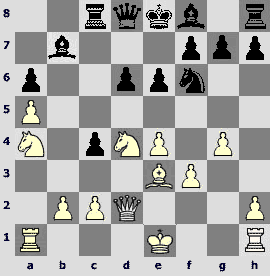
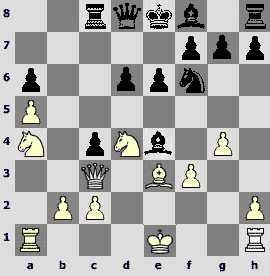
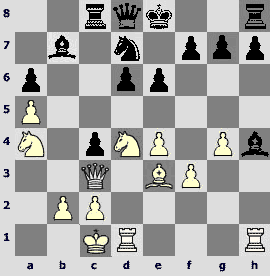
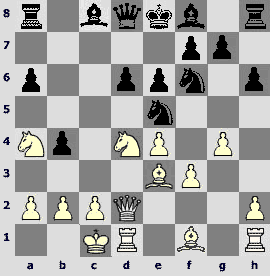
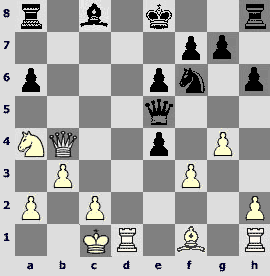
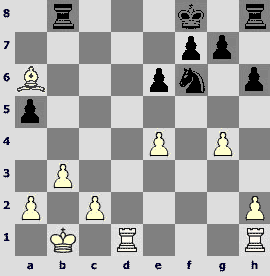
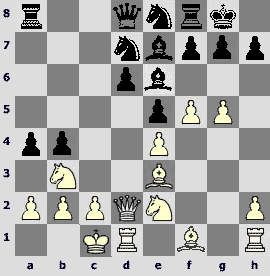

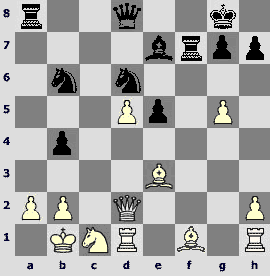
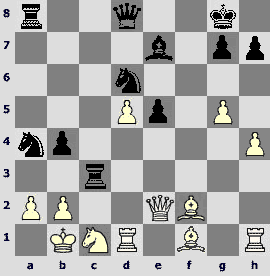
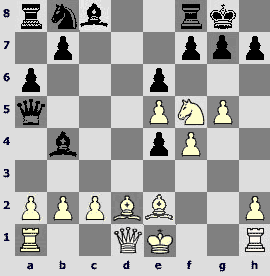

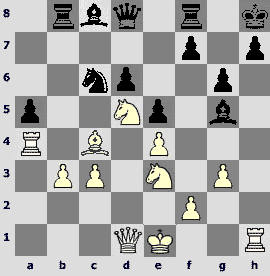
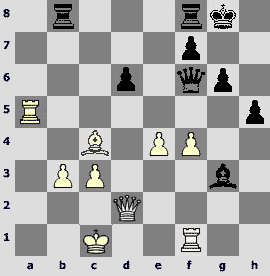
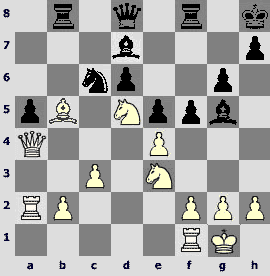
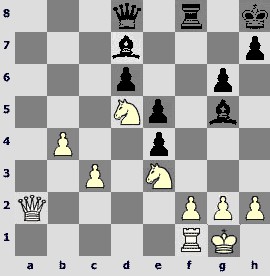

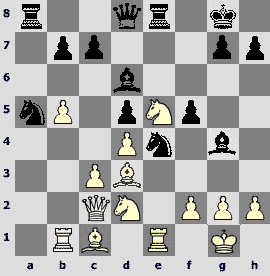

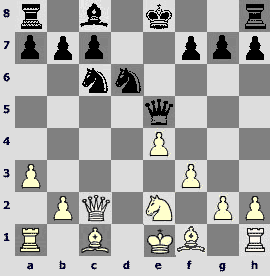
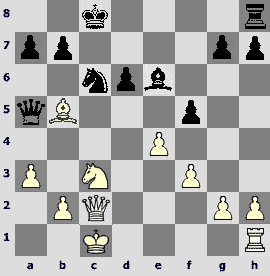

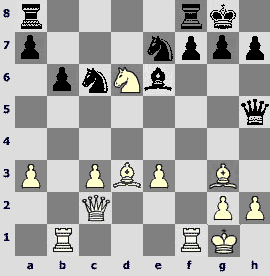

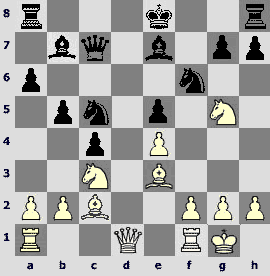
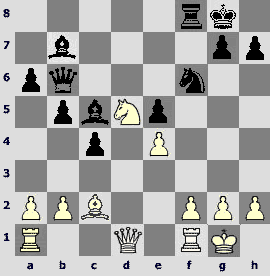
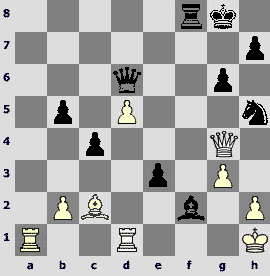
ALL ARTICLES BY AUTHOR
| The best game of May: Sutovsky – Sokolov |
| S. Ivanov. Theoretical survey of the Linares tournament |
| S.Ivanov. The supertournament in Sofia: no compromise and struggle evasion! |
